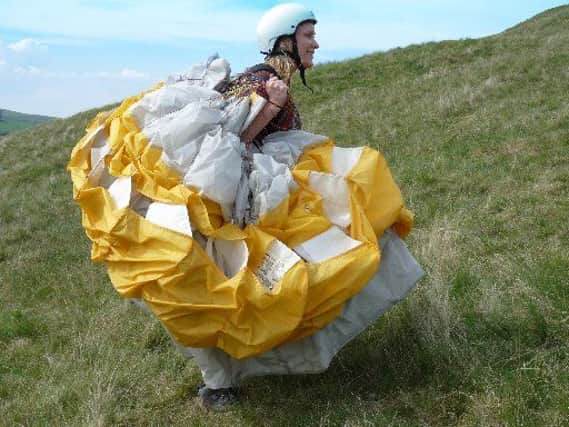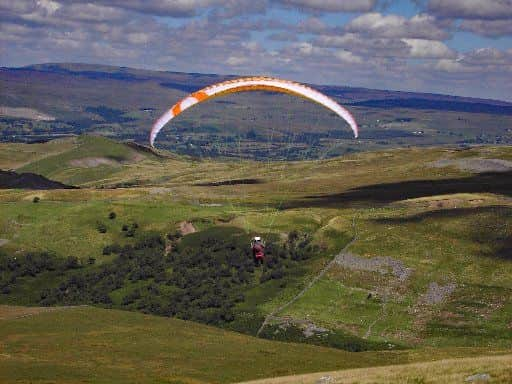Why Yorkshire has become a paragliding hotspot


When it comes to learning the art of paragliding, countries like Portugal or France have an obvious advantage. There’s the weather for a start. By stringing together several consecutive sunny days of flying, a complete beginner can become a qualified pilot reasonably quickly.
While Yorkshire might not have as much guaranteed sunshine as its European neighbours, flying above the Dales does have a major plus in its favour. Last year’s extension of the Yorkshire Dales National Park boundaries means it now includes some of the best paragliding in the country, from hilltops in the Howgill Fells next to the M6 and stretching to Sedbergh and Kirkby Stephen.
Advertisement
Hide AdAdvertisement
Hide AdEven before 2016, Yorkshire contained great soaring sites. There’s a number clustered around the market town of Hawes, Semerwater provides another popular launching point and Wether Fell in Wensleydale is magic when the wind is right.


However, the recent addition of the Howgills means it now boasts more top soaring sites than ever before. Tailbridge on the Cumbria-Yorkshire border is among the best and it’s where Ian Brown and colleagues from Kirkby Stephen-based Sunsoar Paragliding can often be found tutoring a group of beginners. “On a fine day, the Yorkshire Dales National Park is a paradise for soaring,” says Ian after touching down on the sheep-cropped turf from where he first took off.
“Beginners often ask: ‘Do we jump off a cliff?’ We don’t. A nice flat shelf on the hillside will do for starters. Initially it’s simulated flying – a bit like learning to ride a bike with stabilisers. Yet within a couple of hours everybody is flying solo. In fact, paragliding is the only aviation sport where you can actually go it alone on your first day.
“On a first day novices initially skim above the ground in hops of 50-100 yards downhill. The feeling when they are able to do this by themselves is incredible.
Advertisement
Hide AdAdvertisement
Hide Ad“As I give my first morning talk everyone looks so apprehensive. But by the evening how things have changed – they just can’t believe they’ve been able to fly on their own.”


On the second day Sunsoar students, who are aiming for a British Hang Gliding and Paragliding Association qualification, move higher up the slopes. There they learn about hitching lifts on columns of rising air to gain height.
“Once I found myself soaring in a thermal with the pair of golden eagles that then lived in Lake District,” says Ian. “Magic. They just soared higher and higher alongside me. And no, I didn’t feel threatened at all.”
Such air currents are triggered by different things like, say, a ploughed field which absorbs and releases the sun’s warmth. By soaring hopscotch fashion from thermal to thermal, paraglider pilots are able to fly cross country.
Advertisement
Hide AdAdvertisement
Hide AdOn landing they phone a partner or friend who, once they know where to head for, will drive out and retrieve them. Quite recently Sunsoar instructor Brian Doub flew 90 miles from A to B.
“Seagulls, by way of contrast favour soaring along ridges and skylines,” says Ian. “Wind blowing uphill here generates the lift. So these particular birds favour soaring backwards and forwards along the ridge on the uphill draught, just floating up and down.
“It just shows how paragliding has developed. That was how pilots used to soar during the sport’s early years. Just like seagulls, they would use one hill facing the wind for lift and stay with it all day.”
Pilots now aim to strike out across-country rather than just sit in the updraught over one hill all day.
Advertisement
Hide AdAdvertisement
Hide AdIn recent years Ian reckons paragliding kit has improved beyond recognition.
“Originally paragliding equipment was primitive. But nowadays we have what we call ‘low-level wings’. They are very safe and have increased in performance so dramatically we don’t need to upgrade any more if we feel you’d like a higher-performance wing.”
And the cost? Say £500-£600 for a harness and £2,500-£3,000-plus for a wing, though buying second-hand halves these prices. Expensive?
Ian shakes his head. “Depends which way you look at it. Golfers pay that for a set of new clubs.”
For more information about paragliding visit bhpa.co.uk or sunsoar-paragliding.com